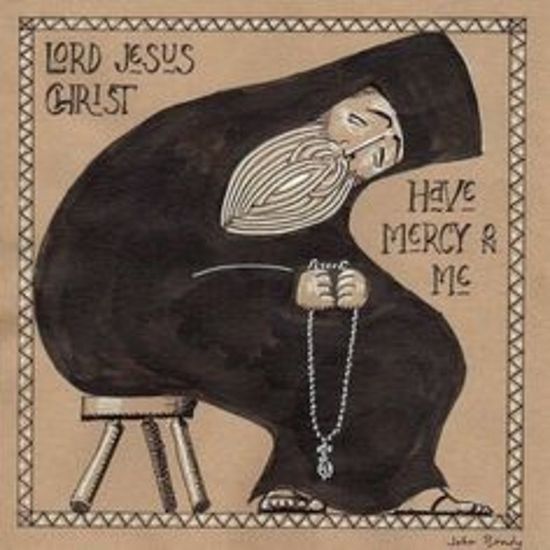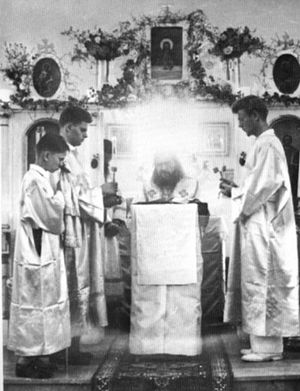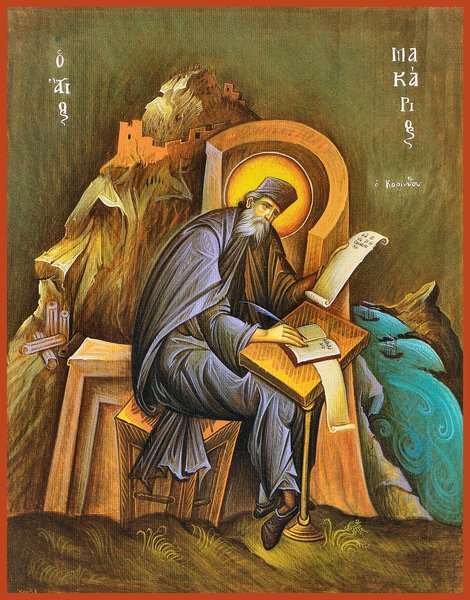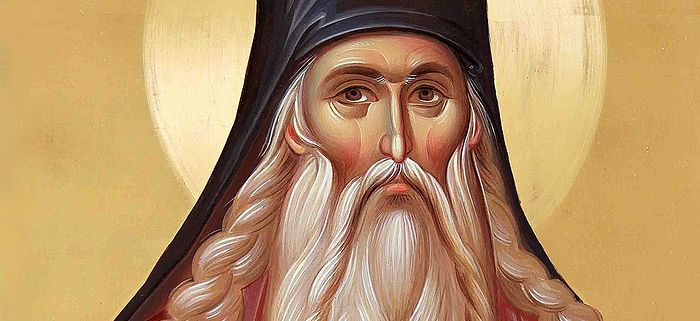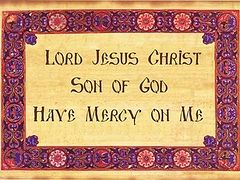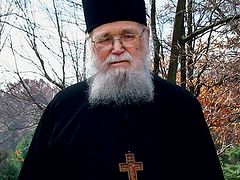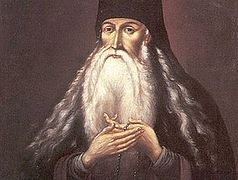The Orthodox Church is a bottomless spring of spiritual wisdom, granting the eternal life of Christ to all who ardently seek it. Through the millennia this wisdom has been captured for us in part in the writings of the Fathers, the lives of the saints, and the various collections of sayings of the monastic fathers. Among the most prized literary possessions of the Church is the spiritual classic The Philokalia, which compiles the centuries of the Church's spiritual wisdom for the faithful in their battle against the passions towards the attaintment of virtue and the holiness of Christ.
The present article is the third lecture in the series: “Prayer of the Heart in an age of technology and distraction” delivered by Fr. Maximos (Constas) in Feb. 2014 to the clergy of diocese of LA and the West of Antiochian of N. America at the invitation of His Eminence Metropolitan Joseph. The audio version of this lecture first appeared on Patristic Nectar Publications, and is published here by permission.
Fr. Maximos is the presidential research scholar at Holy Cross Greek Orthodox School of theology in Brookline, MA. He is an Athonite monk, one time professor at Harvard Divinity School, accomplished author and translator and lectures internationally in both academic and parochial venues.
There’s always more to say about technology but I think we said enough and made the key points. In the last talk we spoke of the surface appearances and distractions from the depth, and now it’s time to turn in the direction of the depth and slowly begin to explore what sort of resources the Church has for us to become people of the depths and people of prayer.
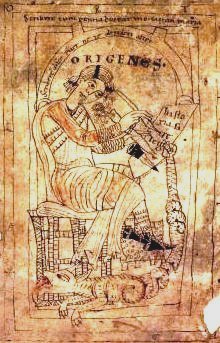 Origen, the "teacher" of many Fathers
Origen, the "teacher" of many Fathers
The word “philokalia” means the love of beauty, as “philosophia” means the love of wisdom. Dionysius the Areopagite in On the Divine Names says “kalos” means beauty, so “philokalia” is the love of beauty, but here of course the love of divine beauty. St. Dionysius also offers an etymology of the word “kalos” which comes from the word “kalin: which means “to call, invite, or beckon,” because beauty is that thing which calls us, draws us, that beckons us, and we’re all drawn to beautiful things, and of course the beauty that inheres in all beautiful things is the beauty of the Divine. So the ultimate beauty that exerts its magnetic pull on us is not a beautiful face, or landscape, or piece of music, but it is ultimately the beauty of the Divine which is refracted or reflected in these earthly beauties. So “philokalia” means the love of the beautiful.
It’s’ a collection of writings, either whole or in part, from forty or so ecclesiastical writers on prayer, and on the spiritual life very broadly understood. By that I mean the struggle with the vices, the acquisition of virtues—everything that can fall under the spiritual life. And this collection runs from the fourth—fifteenth centuries, so in a sense it’s a kind of library that seeks to present comprehensively all of the spiritual riches of the Orthodox Church. It was published in the late eighteenth century in Venice by two men who were later canonized—St. Makarios of Corinth and St. Nikodemos of the Holy Mountain, who collaborated to compile and edit it. It’s important to note that despite its having been published in 1782, it’s not to be thought of as a kind of eighteenth century invention. Some people think it’s a later, specifically Athonite thing. This couldn’t be further from the truth, and actually it’s part of a much more ancient collection of writings.
Already beginning in the third-fourth centuries, ascetic literature began to proliferate. There are simply a lot of writings to read, and the material continued to proliferate, and many lifetimes aren’t enough to read through it, so it was natural and necessary for people to start to select certain works from the large body of literature and give them a kind of priority. Out of the larger body of ascetical literature a canon within the canon began to appear, and I think this is something people have lost sight of, because we tend to read very randomly now. “Oh, I think I’ll read The life of Moses by St. Gregory of Nyssa because that seems interesting, then I’ll have a look at something by Evagrius.” There’s a great pool of literature and we think we can select things at random. That is not how people being formed in the spiritual tradition of the Orthodox Church read. There was a curriculum, if you will. There was a canon within the canon that was part of the way people were formed. This is already the case with the sayings of the desert fathers—there were multiple collections that were redacted and came to be formed. There were many local collections from various sketes that were combined, and so there was a process by which this often unwieldy literature was made much more accessible for people.
If we jump forward to the ninth century, there’s a work by Patriarch Photios of Constantinople called the Library or Myriobiblos, which is essentially a series of hundreds of book reviews, including everything from classical to ecclesiastical to scientific literature. He was very learned and read voraciously and wrote essays on what he wrote. Some of these are important because he reviews books that don’t exist anymore and we know about them only from his work, especially works from pagan antiquity. There is a section in which he reviews ascetic literature, and if you look at the authors and works he reviews you can already see that something like the Philokalia is beginning to take shape, because much of what he selects is also in the Philokalia. The eleventh and twelfth centuries were a time of anthologies and compilations—it’s when the great Gerontikon is established and also the Evergetinos, which is a multi-volume work that excerpts material from saints’ lives, ascetic writings, Church Fathers, and arranges them under thematic headings, such as patience, poverty, repentance, etc. Paul, of the Evergetis monastery, from a lifetime of reading culled all of these good bits about various topics and arranged them, and we’re very glad he did because if we want a quick survey from the spiritual tradition on any locus or topic you can go right there. This is what happened with the ascetical literature, forming a curriculum.
The high watermark of this process was in the late Byzantine period under the hesychasts such as St. Gregory Palamas, Philotheos Kokinos, Theophanos of Nicea, Ignatius and Kallistos—there are so many remarkable writers form this period. These men were masters of prayer, of the spiritual life, and they had the responsibility for forming and initiating others into this life; and part of that initiation included a reading list. So we have compilations from the hesychastic period of the thirteenth and fourteenth centuries that contain up to sixty percent of the same writings in the Philokalia. This isn’t just some eighteenth century invention, but a tradition of reading for spiritual formation and initiation into the life of prayer that was basically crystallized in the late Byzantine period under the hesychasts, and then diffused into the Slavic world, with close contact between Byzantine theologians and hesychasts and the Slavic world. We have manuscripts on places like Mt. Athos that we call pre-philokalic collections or philokalias before the Philokalia. I say all of this because I think it’s important to point out that it’s not a latecomer to the life of the Church but rather something that’s been a part of the Church’s experience from antiquity.
Now I want to say something about St. Makarios of Corinth and St. Paisius Velichkovsky, the great Romanian[1] starets, who are part of this story. They are two spiritual seekers, who are devoted to the life of prayer and want to deepen their knowledge of prayer. They’re two parallel speakers beginning in two different places with no knowledge of each other, but their paths eventually cross, and it’s a fascinating story. St. Paisius actually wrote an autobiography, which is a wonderful thing because we have so few from anyone in the Church, and unfortunately he stopped working on it when he went to the Holy Mountain. It describes his life with his parents from childhood, his early theological education and his early monastic life, but then when he leaves for Athos the record stops, which is to be regretted because his work on the Holy Mountain is very important. He went to theological schools but he didn’t like them, thinking they were too academic and western. The curriculum didn’t correspond with the spiritual life he was seeking, so he went to a monastery but didn’t like it there, and then he found a home in a skete where he was exposed for the first time to philokalic writings, in Slavonic translation. His spiritual father there, St. Basil, had a small library of philokalic texts, and this was part of his initiation into the Jesus Prayer and the practice of the inner life. When he found out that there were more texts like this, he was inspired by God and set out to Mt. Athos to find all of this literature to compile it.
Of course his Greek wasn’t very good and he was looking for the Slavonic versions. When he arrived to the Holy Mountain and was searching through various libraries, he immediately ran into a very serious problem that would hobble him for the rest of his life—that to his horror there existed more than one Slavonic translation of any particular work. He found the work of Peter of Damascus in one Slavonic translation, but then to his surprise he found another that differed significantly, and then a third and fourth translation. So now there are four versions in the same language of a single text, and he has to start collating these things. Sometimes he would come across a very important term, and out of four manuscripts there were three different words—which was the right word? So he had to stop and start learning Greek—he had work for the rest of his life. He eventually left the Holy Mountain with his disciples and returned to what is now Romania, and continued this work of collating and translating the Philokalia in places like Neamts and other very famous Romanian monasteries. So the first to have this idea to collect and publish the Philokalia as we know it was St. Paisius.
The other parallel seeker is St. Makarios of Corinth, who was from a very wealthy family. His last name was Notaras which was a big influential family, including patriarchs of Jerusalem and many high ranking ecclesiastical dignitaries, basically running the southern part of Greece. At a very young age he was made the metropolitan of Corinth, probably from the influence of his family. This is before 1821, in the middle eighteenth century. There is Russian influence in the Ottoman Empire, and they are colluding with the Greeks to overthrow the Ottomans. Before the revolution of 1821 there were several attempted but failed revolutions. One of them cost St. Makarios very dearly, because his powerful family was in league with the Russians; there was a Russian battleship off the coast of Corinth and his brothers were in collusion with the Russian naval officers. The idea was to trigger an uprising and throw off the Ottoman yoke. I think the Russian admiral was named Orloff and this is called the Orloff affair. Things didn’t go well, and when the Greeks began to lose the fight the Russians began to back away; the Ottomans called in the Albanians and there was a mass slaughter. Not only were St. Makarios’ brothers killed but his whole family had to leave Corinth—it was a tragedy. It was a huge trauma for him—he lost everything he had. He ended up with nothing, and after the revolution subsided he was never allowed to return to his see. The Ottomans said he could not return as the metropolitan of Corinth, and the patriarchate had to agree to that, so they gave him a stipend and let him maintain the title and the allowance to serve anywhere he liked, but he could never return. So this man from a wealthy aristocratic family began to live as a hermit on the island of Hydra as a humble, socially reduced hesychast living on an island in the Aegean.
The story gets very complicated, but I have to add another element here which is the affair of the Kollyvades. This was a movement on Mt. Athos among a traditionalist party that ran into a conflict with other monks on the mountain who did not share their views. There was a tremendous fight and the Kollyvades were all expelled from the mountain. They were scattered throughout the Aegean and one of these Kollyvades ends up on Hydra and he meets the retired metropolitan and sees him struggling to live a hesychastic life, but Makarios doesn’t know the Jesus Prayer tradition. Sylvester, the monk also in exile, knows all about it and has a manuscript with him with all these philokalic texts. He initiates St. Makarios into the Jesus Prayer tradition, and he also conceives the idea just like St. Paisius to organize and publish these texts as found on Mt. Athos.
So there were these parallel seekers, for a Slavonic and Greek Philokalia. Their paths eventually met and they corresponded, and St. Nikodemos then enters the scene, because St. Makarios enlisted him when he was a monk at Dionysiou, much younger and full of energy. He was very bright and had a photographic memory. He helped bring the Philokalia together, was asked to write an introduction, and helped see it to publication in Venice. When the Greek Philokalia was published a copy was sent to St. Paisius. You would have thought that this poor man who spent his whole life bringing his own Philokalia to publication would have been despondent or crestfallen to see himself beat to the punch, but he was overjoyed to have the text in Greek, which he could now use to correct his Slavonic text and bring his vision to light in the best way.
There’s another story about translations—St. Paisius was very old and basically confined to his bed in the monastery, and pilgrims who would visit him in his cell saw him lying in bed with dictionaries and lexicons stacked up around him. He continued to work on this until the day he died. He had a friend Gabriel who was the metropolitan of Novgorod who became impatient with St. Paisius’s pace—he wanted this Slavonic Philokalia and so he said he would finish the draft. He thus formed a committee of three professors, philologists, and three monks to finish the work. After a few weeks one of the professors told the metropolitan he needed to talk to him about something. He says, “What is it?” and he says, “You’ve got these three monks on the committee and they don’t even know Greek.” The metropolitan answers, “And you don’t know anything about mystical experiences, so get back to work.” We form translation committees today often simply on the basis of their philological credentials and nothing else. They may have no poetic sensibilities, they may not even be people of the Church, but we choose them because they have a degree that says something in a dead language. I admire the vision of Gabriel of Novgorod who put together a committee that would illuminate the historical and philological side of the text, but also its correct interpretation.
Of course the Slavonic Philokalia was published a mere eleven years after the Greek and went on to have a celebrated reception in the Slavonic world, more than in the Greek world. In the Greek world the Philokalia went nowhere. It sank like a stone, because a few short years later the Greek revolution took place and the Greek government was given to Europeans. The first king of Greece was a Bavarian, who he began a program of westernization, and monastic life was suppressed—the audience for a book like the Philokalia basically vanished and it wasn’t until the 1950’s that Greece returned to a serious engagement with the Philokalia. But it had a huge and unanticipated success in the Slavonic world, where it stimulated a tremendous renaissance of spiritual life in late-nineteenth century Russia. The tradition of the Optina elders is essentially philokalic, as is that of St. Herman of Alaska. When he went to Alaska, the metropolitan sent him a copy, which they now have in the archives of the seminary on Kodiak Island, so from the Aegean and Mt. Athos this compilation made it all the way to America. To me this is astounding.
The Philokalia is the high mathematics of the whole Tradition. But that’s not really fit for the whole Church, so The Way of a Pilgrim was written. If the Slavonic Philokalia is advanced calculus then The Way of a Pilgrim is sort of Gospel. It’s a narrative. It’s the Gospel in the sense that it’s the chief tool for evangelization of the tradition of the Jesus Prayer; and I daresay that many who practice the Jesus Prayer do so because of that book. I know it’s true in my case. We learn about the Philokalia through the pilgrim because that’s what he’s reading. That book alone has been so tremendous in the dissemination of the philokalic tradition.
Many of us may have understood at some point in our lives that the Philokalia is an important book, said to be a definitive statement of the Orthodox spiritual life, and we all want to cultivate our spiritual lives, so we go and buy it, thinking we’ll sit down and read it and have some incredible experience. So we start reading, we turn one page and another page, we finish one author and maybe a second and third, and we have no idea what’s going on. We think, “This is supposed to be some kind of spiritual classic?” It seems so random. “What is the point of all of this? What am I supposed to focus on?” If you finish volume one, then congratulations—you’re in a minority. Most of us put it aside. The problem is that we don’t know why St. Nikodemos and St. Makarios arranged the text in chronological order. What’s important is that the Philokalia was never meant to be read in that order—never. And yet that’s the way we try to read it because we don’t know there was another order, another path of initiation into the Philokalia and Jesus Prayer much more simple, direct and effective. You’ll never get that if you read from volume one on, because the first item in this unwritten tradition is that the first work to read is in volume four, and most don’t even get there; and when you do you wouldn’t know that the starting point is there.
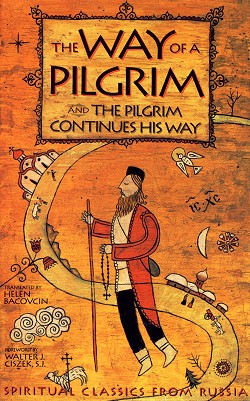
I have my students begin reading in this order:
A chapter from St. Nikodemos on guarding the mind and the heart from a book called A Handbook of Spiritual Counsel. This chapter on guarding the mind and the heart is, to my knowledge, the very best thing that anybody could read on the nature of the mind and heart, because St. Nikodemos wrote this after years of engagement with the Philokalia, tracking down the texts, and meditating on and practicing the texts. After all of that, he wrote this chapter, which is a consummate summation of the whole tradition on the nature of the mind and the heart. There’s nothing like it. If you haven’t read it, this should be the next place you go. It gives the big picture in a very succinct and clear way. I didn’t know who I was before I read this. I didn’t know what the mind and heart are and how they’re related. I had different ideas but didn’t see the whole picture clearly. I give this to my students to read because it’s the most helpful—it contains everything to follow in summary read.
The next thing I have them read is St. Nikodemos’s introduction to the Philokalia. I don’t know why, but I think it was a terrible mistake that the English translators deliberately chose to exclude his introduction from the work. He was the editor and compiler; he knew what he was doing. But for whatever reason the three British translators decided not to include it. So you start to read the book and there’s no framework, no induction, no initiation as was intended to be. We now have a 2008 translation by Constantine Cavarnos, so now we can read what St. Nikodemos was up to in compiling the work—what he believes this collection is all about. He talks about the universality of the Jesus Prayer—not just for monks and nuns—and he makes a lot of important statements about the connection between the Jesus Prayer and the sacramental life. It should never have been omitted. It’s the bridge from the outer world to the inner world of this work.
The first item that anyone tells you to read from this unwritten tradition is the short work from St. Nicephorus the Hesychast or Solitary, On Watchfulness and the Guarding of the Heart. It’s very short and simple. He teaches you what the Jesus Prayer is. He says something about the breathing practices that help to concentrate the mind, and then he has a little anthology, a philokalia within the Philokalia, of excerpts of the lives of the great ascetic saints from antiquity, because he wants you to see that this practice is ancient and that all of the great ascetics practiced inner attention. The second item by Sts. Kallistos and Ignatius is a much longer work that goes into much more detail about the Jesus Prayer. It is written for a monastic audience with a lot of information on how one should live; it is concerned with things like diets, how much to eat and when, how much sleep, etc. Much of this is relevant only for those living a more hesychastic life. So it’s a question of discernment of what to apply to ourselves, but everything they say about the Jesus Prayer is extremely valuable, and they ground the practice of the Jesus Prayer in the sacramental and liturgical life of the Church. It’s not something people just do in caves, but it’s a practice for the whole Church and it’s deeply rooted in the sacramental life.
Nicephorus gives us a very gentle, welcoming invitation to the practice of the Jesus Prayer, Kallistos and Ignatius take us deeper into that, and then we come to Hesychios’ work that talks about thoughts. At this point if you’ve done what Nicephorus and Kallistos say, you will have begun to encounter logismoi.[2] But notice that the Jesus Prayer isn’t introduced with dire warnings about the darkness within. It’s all light and beauty and love and peace, and everyone can say the Jesus Prayer—this is to attract people to the practice. But after a bit you’ll see that you are distracted, you have thoughts, and you can’t say the prayer without images coming into your mind. What does this mean and what can you do about it? That’s where Hesychios comes in. The rest of the texts continue in a very careful and very simple and cumulative induction and introduction to the practice of the Jesus Prayer. If you read these initial texts you will have been properly initiated into the Jesus Prayer, and then after that you can move freely about throughout the collection. Now you can pick up anything and read it and it will support what you received through this miniature syllabus.


